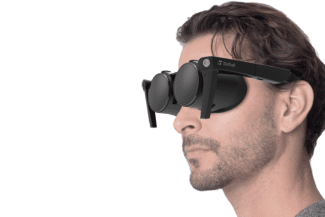Shiftall, a subsidiary of Panasonic, today announced lightweight VR glasses known as MeganeX at CES 2022.
At CES 2020, Panasonic debuted ultra-compact VR glasses that used OLED microdisplays and pancake lenses to deliver a form factor closer to sunglasses than many other VR headsets. Then, in 2021, the company introduced a revised form factor with support for six degrees of freedom (6DOF) movement. The MeganeX appears to be the first consumer iteration of this device, with a twist.
MeganeX SteamVR Headset Announced
Many of the specs are identical to those of Panasonic’s prototypes. MeganeX employs 1.3-inch microdisplays offering 2,560×2,560 resolution per eye at 120Hz. It houses Snapdragon’s XR1 chip and weighs in at 250g on its own with foldable frames.
However, despite featuring the XR1, no standalone support for MeganeX has yet been mentioned. Instead, the headset supports SteamVR via USB connection (and the 250g weight doesn’t account for the wire). A compatible controller hasn’t been revealed, but the company says information on that will be coming soon. Shiftall does say there will be support for other platforms in future updates, but doesn’t specify as to what this means.
In a 2020 video, Shiftall CEO Takuma Iwasa described the company’s specialty for Panasonic as a “very short time development and a small quantity of mass production” so that the company can then “trial and error on the market.” It’s quite possible, then, that we see a very limited rollout of MeganeX as the company prepares more advanced standalone capabilities for the future.
As for release, the company says the glasses will ship “to global markets” this spring for “less than $900”.
We are seeing increasingly compact VR headsets begin to hit the market. In late 2021 HTC released the Vive Flow, which needs to be tethered to a power source and is mainly intended for media-viewing via phone mirroring, with some limited games and apps also available.
Elsewhere, Shiftall also announced a “personal air conditioner” for VR called the Pebble Feel that aims to simulate heat in VR environments and a bluetooth microphone designed to suppress leaked sound.
We’ll have plenty more from CES 2022, so stay with us.






